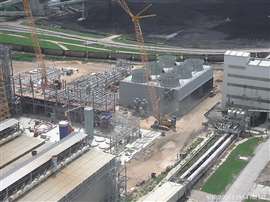DOE plans CO2 infrastructure funding
August 28, 2023
Money will be earmarked for transportation infrastructure projects, including pipelines
The U.S. Department of Energy (DOE) plans to provide funding for carbon dioxide transportation infrastructure to help reduce carbon emissions.
The DOE’s Office of Fossil Energy and Carbon Management issued a notice of intent (NOI) to supply the funding under the carbon dioxide transportation infrastructure finance and innovation (CIFIA) program. CIFIA will support common carrier carbon dioxide (CO2) transportation infrastructure projects, including pipelines, rail, ships and barges, and ground shipping, that connect anthropogenic point sources of CO2 with endpoints for storage and utilization.
 The Petra Nova CCS project is designed to capture approximately 90 percent of the carbon dioxide (CO2) from a 240 MW slipstream of flue gas and use or sequester approximately 1.4 million metric tons of this greenhouse gas annually. (Image: Department of Energy)
The Petra Nova CCS project is designed to capture approximately 90 percent of the carbon dioxide (CO2) from a 240 MW slipstream of flue gas and use or sequester approximately 1.4 million metric tons of this greenhouse gas annually. (Image: Department of Energy)
Carbon management technologies such as carbon capture from industry and power generation, direct air capture, carbon conversion, and CO2 transportation and storage technologies must be deployed at a large scale in the coming decades to meet the United States’ net-zero greenhouse gas goals by 2050, the DOE said.
America’s carbon transport system is already of significant scale—including multiple methods such as truck, freight, and pipelines that together transport almost 60 million metric tons of CO2 per year, the DOE said. Carbon capture projects in the United States are predicted to capture and store 65 million metric tons of CO2 per year by 2030, 250 million metric tons of CO2 per year by 2035, and 450 million metric tons per year by 2040. To accommodate the rapid growth of carbon capture and storage industry, the country will need to significantly expand the infrastructure to transport carbon dioxide over the next decade.
If issued, this funding opportunity announcement (FOA) will provide CIFIA future growth grants to provide financial assistance for developing and building extra CO2 transport capacity up front that will then be available for future carbon capture and direct air capture facilities as they are developed and for additional CO2 storage and/or conversion sites as they come into operation.
Significant economic benefits can be achieved through economies of scale—by making additional up-front investments now to provide enough CO2 transport infrastructure capacity to accommodate potential CO2 supplies that are expected to come into operation at a later time. Investments in additional capacity made available by CIFIA future growth grants can help avoid future construction of separate, redundant transport networks, as well as associated environmental impacts. The additional transport capacity also may incentivize CO2 emitters to make the capital investments required to capture CO2 at their facilities by providing assurance that the captured CO2 can be moved safely, reliably, and cost-effectively to geologic storage or other end-use locations.
To prepare for the upcoming issuance of this FOA, prospective applicants are encouraged to read the full NOI. DOE expects to issue the FOA during the fourth quarter of calendar year 2023.
MAGAZINE
NEWSLETTER
CONNECT WITH THE TEAM






